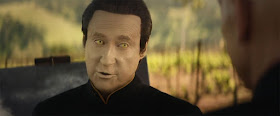On Monday night, my friend Chris and I went to a showing of 1917, a gripping, dramatic film which really doesn't need to rely on the additional trick of being a single extended shot (well, two shots, to be accurate, the main character is knocked out at one point in the film). It's a timely viewing, given that I've just finished reading one of the books that I purchased during my recent Toronto trip: 1917 - Wasteland: The Great War and the Origins of Modern Horror, by W. Scott Poole.
It's Poole's contention that modern horror finds its origins in the literally horrifying environment of the trench war: mud, blood, mold and decay, a hellish landscape punctuated by fetid shellholes, unburied bodies, and mutilated soldiers.
Art is always a window into its own time and place, and I certainly agree with his comments regarding the influence of the war on artistic movements such as Dada and Surrealism, and its role in the rise of fascist politics as a response to the chaos of the battlefield, but the connections he makes to the genre of early 20th Century horror don't have the same authority for me.
Historically speaking, almost all of the best known stories that lay the groundwork for horror as we know it today predate World War One: Mary Shelley's Frankenstein revived his monster in 1818, Edgar Allan Poe wrote The Telltale Heart, The Cask of Amontillado, and The Fall of the House of Usher in the middle of the 19th century, Robert Louis Stevenson published The Strange Case of Dr. Jekyll and Mr. Hyde in 1886, and Bram Stoker's Dracula made its debut in 1897. H. G. Wells, whose writing is admittedly considered to be more science fiction than horror, released The Island of Doctor Moreau in 1896 and The Invisible Man in 1897.
The villain of The Phantom of the Opera, written in 1909, is deformed from birth, rather than due to the misfortunes of combat. Ambrose Bierce, noted literary creator of the odd and the uncanny, vanished in Mexico and was presumed dead in 1914, and Howard Phillip Lovecraft, commonly cited as one of the most influential figures in the development of the horror genre, wrote his first published tale of indescribable eldritch monstrosity in June of 1917, a month before the start of the war.
The equally classic horror films of the post-war era draw heavily upon that pre-war catalogue of horror fiction, with movies such as The Phantom of the Opera, 1925; Dracula, 1931; Frankenstein, 1931; Island of Lost Souls, based on The Island of Dr. Moreau, 1932; and The Invisible Man in 1933.
However, it's Poole's contention that the success of these films, regardless of their source material, reflect a specific post-war zeitgeist: Frankenstein's patchwork monster represents the fragmentary corpses of the trenches and craters, the Phantom's mask (and ruined visage) echo the masked faces of mutilated veterans, and the bandages seen on the Invisible Man and the Mummy are the same bandages that cocooned wounded soldiers. Dr. Moreau's surgical theatre, the "house of pain" of the movie, reflects the harrowing, nightmarish procedures of the front line hospitals.
For me, the strength of Poole's thesis lies in extending the effects of the first world war through the rise of fascism in Europe and from there into the origins of World War II, which seems far more resonant in terms of its genre influence. In my mind, World War II, or more accurately, the events of the Holocaust, represent a more significant line of demarcation than World War I in terms of its effect on the continuity of horror to the modern day.
It’s much easier for me to connect the psychopathic physical brutality of movies like Psycho, the Halloween, Saw and Friday the 13th franchises, and a myriad of other slasher films, to the Nazi concentration camps in their shared inhuman indifference and disregard for the human body. World War II is more commonly associated with the spectre of nuclear destruction and the effects of radiation on the world, but it also revealed a more subtle and frightening truth: the idea that the most horrifying, cold-blooded and pitiless monsters can actually be other human beings.
- Sid






































